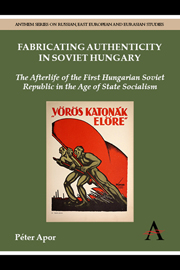 Fabricating Authenticity in Soviet Hungary
Fabricating Authenticity in Soviet Hungary Book contents
- Frontmatter
- Contents
- Acknowledgements
- List of Illustrations
- List of Abbreviations
- Introduction
- Chapter 1 Prefiguration: The First Hungarian Soviet Republic and the Rákosi Dictatorship before 1956
- Chapter 2 Resurrection: The Emergence of 1919 and the Counterrevolution after 1956
- Chapter 3 Lives: 1919 in the Postwar Trials of War Criminals
- Chapter 4 Funeral: The Birth of the Pantheon of the Labour Movement in Budapest
- Chapter 5 Narration: History, Fiction and Proof in the Representation of the First Hungarian Soviet Republic, 1959–65
- Epilogue The Agitators and the Armoured Train
- Index
Chapter 3 - Lives: 1919 in the Postwar Trials of War Criminals
Published online by Cambridge University Press: 05 April 2014
- Frontmatter
- Contents
- Acknowledgements
- List of Illustrations
- List of Abbreviations
- Introduction
- Chapter 1 Prefiguration: The First Hungarian Soviet Republic and the Rákosi Dictatorship before 1956
- Chapter 2 Resurrection: The Emergence of 1919 and the Counterrevolution after 1956
- Chapter 3 Lives: 1919 in the Postwar Trials of War Criminals
- Chapter 4 Funeral: The Birth of the Pantheon of the Labour Movement in Budapest
- Chapter 5 Narration: History, Fiction and Proof in the Representation of the First Hungarian Soviet Republic, 1959–65
- Epilogue The Agitators and the Armoured Train
- Index
Summary
The standard popular history book of the 1950s on the origins of the counterrevolutionary regime that ruled Hungary between 1919 and 1944 classified the Horthy regency as a fascist system:
The Hungarian ruling class developed the first European fascism by applying old and new means of oppression, thereby showing – for the first time – what fascism, which would wildly ravage Europe two decades later and drive millions of people to war, looked like. One can hardly find a characteristic feature of Hitler's and Mussolini's dictatorships which cannot immediately be found in the Hungarian fascism. The fear of Bolshevism, the ruthless oppression of the working class and the wild racist incitement were the same in all these regimes. They all demonstrate the same unrestrained rule by the big capitalists and landowners, the same antiprogressive and anticultural attitudes, the same depreciation of the working man and the same social demagogy.
Thus, in 1919 and 1920, it was not merely the seeds of fascism which appeared in Hungary, but rather fascism itself. In the Hungarian fascism of the twenties and forties, not only the fundamental idea but even the participants were the same. In 1919 in Orgovány, and in 1942 at the massacre in Újvidék, the same Horthy stands at the helm; in the middle of the thirties, it was the same Gyula Gömbös, who adjusted the Hungarian fascism to the newly emerged Nazi movement, who was the leader of the extreme right-wing MOVE in 1920.[…]
- Type
- Chapter
- Information
- Fabricating Authenticity in Soviet HungaryThe Afterlife of the First Hungarian Soviet Republic in the Age of State Socialism, pp. 101 - 124Publisher: Anthem PressPrint publication year: 2014


